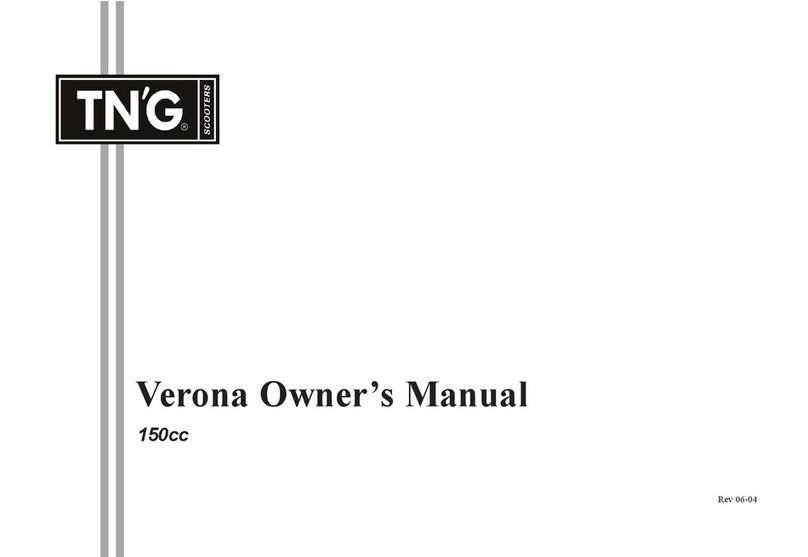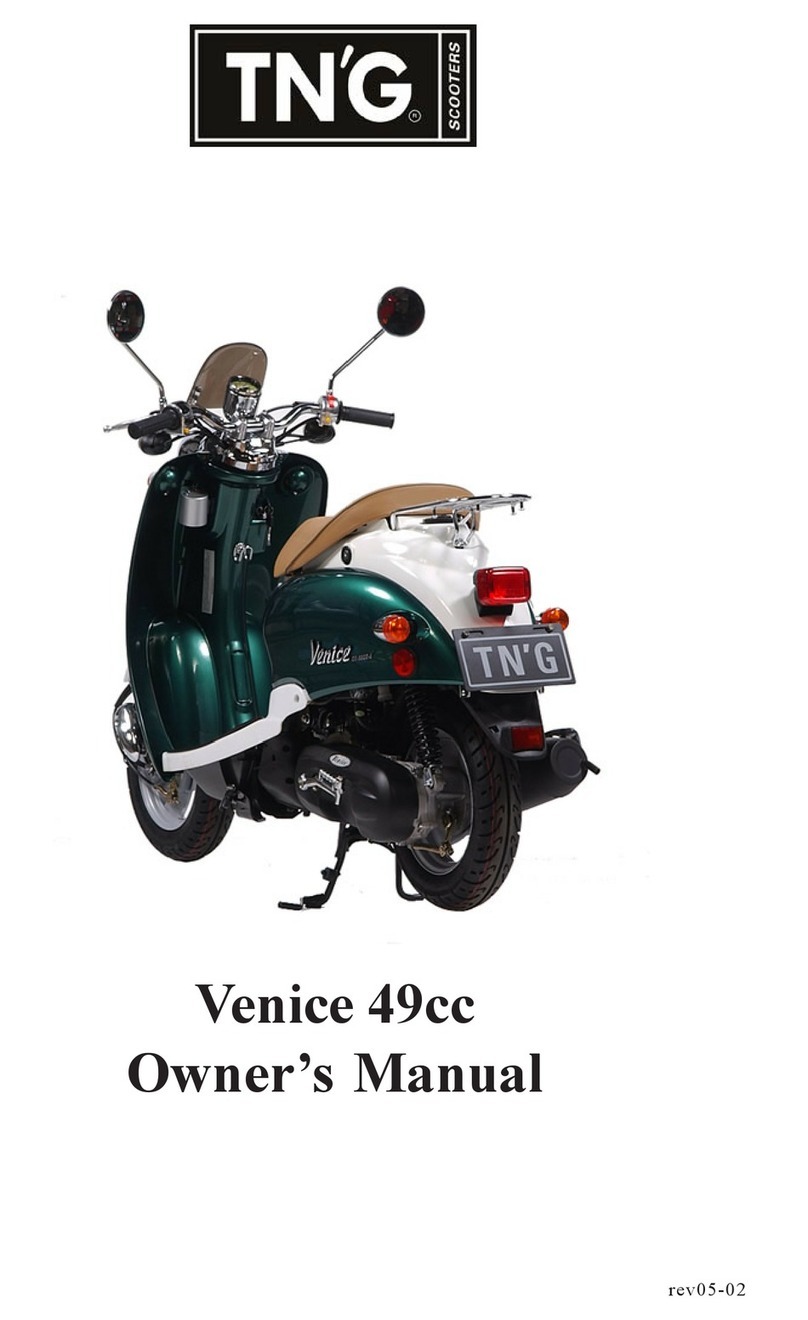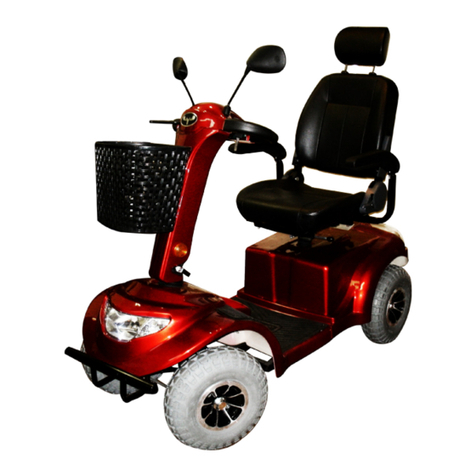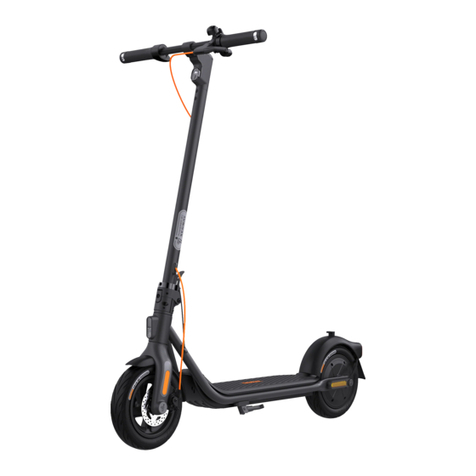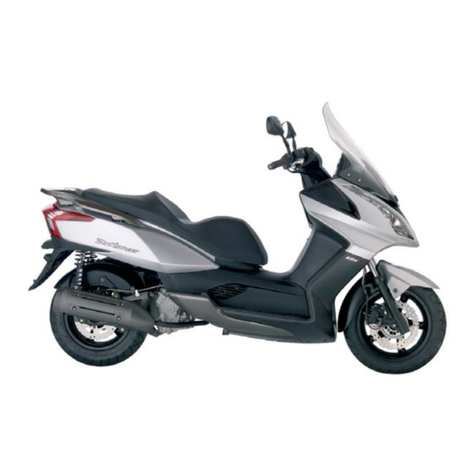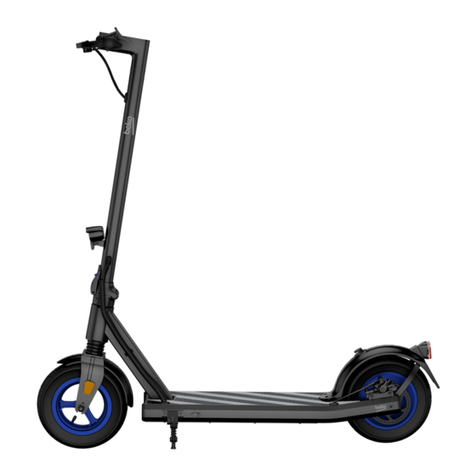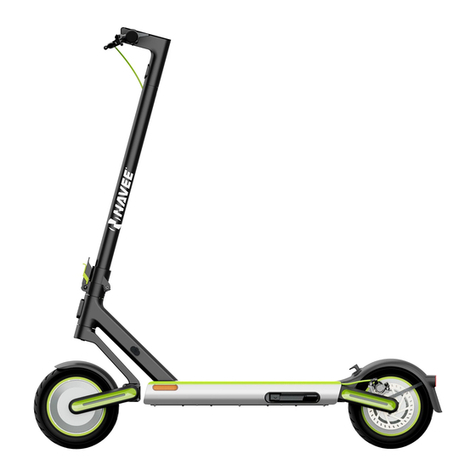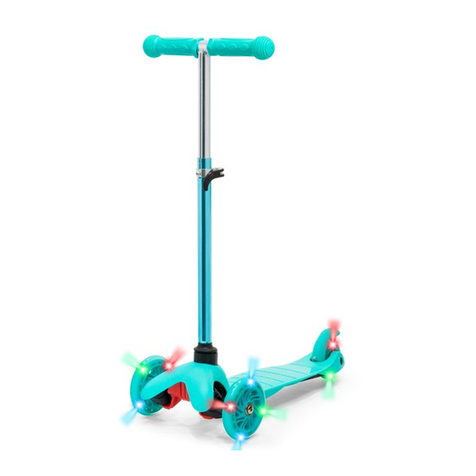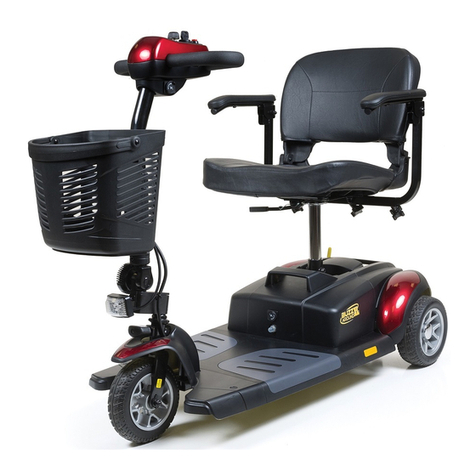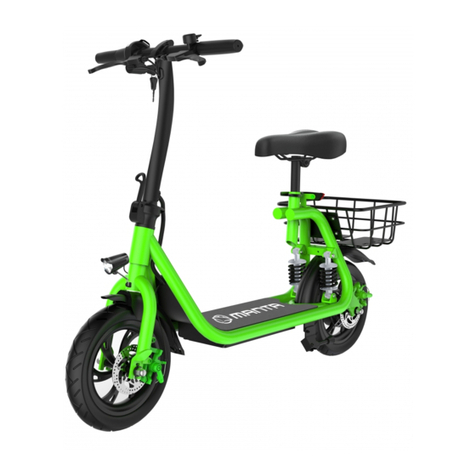TNG Venice LX 49cc User manual

VV
VV
Venice LX 49ccenice LX 49cc
enice LX 49ccenice LX 49cc
enice LX 49cc
Owner’Owner’
Owner’Owner’
Owner’s Manuals Manual
s Manuals Manual
s Manual

Table of Contents
Safety Notes .......................................................................... Page 2
Description ............................................................................ Page 3
Specifications ........................................................................ Page 4
Instruments & Indicators ....................................................... Page 5
Operating Controls ................................................................ Page 6
Pre-Ride Checks ....................................................................Page 11
Operating the Scooter ........................................................... Page 12
Routine Maintenance ............................................................ Page 13
Trouble Shooting .................................................................... Page 19
Ignition Module Replacement ................................................ Page 22
Routine Maintenance Schedule ............................................. Page 23
Scooter Storage ..................................................................... Page 23
Warranty Statement...........................................................Appendix
To download a PDF version of this scooter manual with color illustrations,
visit us at:www.tngscooters.com
Thank you from all of us at CMSI Inc. for purchasing your TN’G Venice scooter.
We trust that you will have many happy & trouble-free travels on your scooter
for many years to come.
SAFETY NOTES
Always obey traffic signs.
Always ride at a safe speed.
Always wear a helmet that fits correctly.
Never wear loose clothing which could catch on the controls or wheels.
Do not carry a passenger.
Do not overload the scooter.
Do not carry more than 3 pounds on the carrying hook.
Do not carry more than 20 pounds in the luggage box.
Be sure there is no source of heat or flame near the scooter during servicing.
Never operate the scooter in an enclosed area.
After the scooter has started, do not touch the hot muffler system.
Carry objects at the designated areas only.
Never modify the scooter in any way.
2

3
DESCRIPTION
Seat
Headlight
Rear View Mirror
2 Cycle
Mixing Oil Cover
Muffler
Throttle
Kick Starter
VIN Number
Rear Brake
Lever
Speedometer
Ignition
Switch
Fuel Filler
Cap (under
seat)

4
Opening the Seat
Insert the ignition key into the seat
lock & turn to the right.
Raise the rear of the seat to the
upright position.
Remove the ignition key.
Closing the Seat
Press the seat down to its normal
position.
Check the seat to make sure that it
is locked in position.
Storage Box
The storage box is located under the seat.
Do not place items that may be damaged by heat in the luggage box.
Do not place fragile items in the storage box.
Do not store valuables in the storage box.
Do not carry oil or fuel in the storage box.
Do not allow water to collect in the storage box.
SPECIFICATIONS
Model Number Venice LX-2
Outer Dimensions (length, width, height) 66.9” x 25” x 41.3”
Wheel Base 46.5”
Ground Clearance 3”
Dry Weight 165 lbs
Load Capacity 330 lbs
Most Economical Speed 20 mph
Displacement 49cc
Compression Ratio 7: 1
Rated Power (with restrictor installed) 2.0 HP @ 7000 RPM
Rated Power (without restrictor installed) 4.3 HP @ 7000 RPM
Spark Plug Type E7TC
Spark Plug Gap 0.7 - 0.9mm
Start Types Electric, Kick
Ignition Type CDI

5
Transmission CVT
Fuel Capacity 5.5 Liters / 1.5 Gals
Rear Drive Oil Type SAE20W-40
Rear Drive Oil Capacity Gear Box (100 cc)
Fuel Mixing Oil Amsoil (Synthetic 2-stroke)
Fuel Mixing Oil Capacity 40 fluid oz
Clutch Dry, automatic centrifugal
Front Tire Pressure 25 PSI
Rear Tire Pressure 30 PSI
INSTRUMENTS & INDICATORS
Speedometer- Indicates the speed of the scooter.
Odometer- Indicates the accumulated mileage in Kilometers.
Turn Signal Indicator- Illuminates when turn signals are activated.
High Beam Indicator- Illuminates when headlight high beam is on.
Fuel Gauge - Shows fuel level.
Low Mixing Oil Indicator- Illuminates when mixing oil level is low.
Speedometer
Odometer
Turn Signal
High Beam
Fuel Gauge
Low Mixing Oil

6
OPERATING CONTROLS
Ignition Switch
(OFF) Power not applied to the lighting & ignition circuit.
(ON) Power applied to the lighting & ignition circuit.
Key cannot be removed from switch in this position.
(LOCK) Steering mechanism locked into place. Key can be removed
from switch in this position.
Steering Lock
To prevent theft, always use the steering lock when leaving the scooter unat-
tended. To apply the steering lock, turn the handlebars fully to the left. Insert
the ignition key in the OFF position, press in the key & turn it to the LOCK
position. Remove the key.
Note: Test the steering lock by swinging the handlebars left & right to be
sure that the lock is engaged.
Hi / Lo Beam Switch
This switch activates either the high or low headlight beam.
Turn Signal Switch
Push this switch either left or right to activate
the left or right turn signals.
Horn Switch
Push this switch to sound the horn.
Turn Signal Switch
Horn
Hi / Lo
Beam
Switch
Off On
Lock

Stop Switch
The Stop switch has two positions:
Stop- Engine stops running.
Run- Engine can run.
Start Button
Turn the key in the ignition
switch to on, hold the rear
brake lever lightly, press the
starter button & the starter
motor will crank the engine.
Release the starter button as
soon as the engine starts.
7
Run
Position
Starter Button
Stop
Position
Rear View Mirror Installation
Screw the installation nut onto the mirror stem
& then screw the mirror stem into the mounting
hole of the handlebar. After the mirror stem is
firmly mounted to the handle bar, tighten the
installation nut with a wrench to prevent the
mirror from turning. Loosen the installation nut
when adjusting the mirror position & retighten
afterwards.
Mirror Adjustment
The side mirrors have two methods of adjust-
ment. They can be adjusted either left & right
or up & down. Use a wrench to loosen the
adjustment nut. (See Fig 1)
While sitting on the scooter, look into the side
mirror and adjust the mirror stem until you see
a clear view of what’s behind the scooter.
Now retighten the adjustment nut.
To adjust the mirrors up & down, locate the
screws which tighten the hand controls on the
handlebars. (See Fig. 2)
Fig. 1
Fig. 2

8
Adding 2-cycle Mixing Oil
Whenever the red “Low Mixing Oil” warning
lamp turns on, you should add mixing oil as soon
as possible. Open the mixing oil cover on the
right side of the scooter and refill the mixing oil
tank with a high quality 2-stroke oil such as
Opti-2. This will protect the engine’s moving
parts and ensure that you will receive the most
power from the engine as well as the longest
engine life. Opti-2 can be found at your local
Twist N’ Go Dealer.
WARNING! Do NOT add any oil to engine
transmission when red oil light turns on.
Adding Fuel
Note: Turn the engine off when refuelling
Remove all source of flame from the area when refuelling.
Unlock and lift seat, remove cap and add fuel. Capacity is approximately
1.5 gallons.
DO NOT pre-mix oil with fuel. Oil will be added automatically during
operation provided the oil reservoir has 2-cycle oil in it.
After fuel is filled, replace cap making sure it is tight and threaded
correctly
Fuel Cap
(Under Seat)

9
Adjusting the Brakes
Rear Brake Adjustment
Park the scooter on its center stand on a
flat surface.
Check the rear brake free play by
measuring how far the tip of the brake
lever will move until it begins to resist
further movement. (See Figs 11 & 12)
Brake lever at rest. (See Fig. 11)
Brake lever travels between 10 & 20 mms
from rest until resistance is felt. (See Fig 12)
Here the lever has been squeezed to the
point of resistance which is approximately 15
millimeters from where it was at rest.
Use a 14 mm wrench to adjust the brake
adjustment nut on the wheel until the brake
lever free play is between 10 to 20 mm.
(See Fig 13)
Fig. 11
Fig. 12
Fig. 13

10
When turning the brake adjustment nut, make
sure that the nut rests in the correct position
when you remove the wrench. The concave
surface of the nut must rest flush against the
pivot pin. (See Fig 14)
Make sure that the brake adjustment nut does
not look like Fig 15! This brake has been
adjusted incorrectly.
The scooter is not safe to ride if the adjustment
nut is not positioned correctly!
Check the rear wheel for drag without the
rear brake being applied. If there is any
drag, loosen the adjustment nut. If there is
too much free play in the rear brake lever,
then the adjustment nut will need tightening.
Note: Adjust the nut only 1/2 turn and
then recheck the brake operation.
Starting the Engine for the First Time
Turn the ignition switch to the “ON”
position, apply the rear brake with the
left hand lever and set the stop switch to
the “run” position (see page 8).
Look to see that the scooter lights are operating. This will verify that you
have installed the battery correctly.
Use your foot to extend the kick start lever.
Quickly press down on the kick start lever with your foot. Immediately
remove your foot from the kick start lever so that it can spring back into
position. If the engine doesn’t start the first time, repeat the procedure.
The engine may require many kicks to move the fuel into the engine for the
very first time. When the engine starts, apply enough throttle to keep the
engine at an idle for 20 to 30 seconds.
Retract the kick start lever back to its original position.
Fig. 14
Concave
CORRECT
INCORRECT
Fig. 15

11
Tires
Tire pressure should be checked frequently. The cold tire pressures are as
follows: Front 25 PSI Rear 30 PSI Tires should be regularly checked for
damage to the rim as well as damage to the tire itself. Look for any cuts,
embedded nails, or other sharp objects. Check for excessive wear as well. If
there is damage to the rim, the rim may have to be repaired and rebalanced
afterwards. The tire pressure should be checked prior to riding the scooter.
(cold)
Fuel
Always check to be sure that you have enough fuel for your trip.
Electrics
After starting the engine, check for proper operation of the headlight and
taillight. Operate the turn signals and horn. Check them to be sure that they
are functioning correctly.
Brakes
Apply both the front & rear brakes and check that they are working correctly.
Also check the brake light for proper operation.
Rear-View Mirrors
Check the rearview mirrors for alignment & damage. Also be sure that they
are clean for the best view.
Reflectors
Check the reflectors to make sure that they are clean & well secured to the
scooter body.
PRE-RIDE CHECKS
Brake Freeplay
When applying a gentle pressure on the front & rear brake levers, check the
freeplay measured at the lever tip. The freeplay should be between 10 and 20
mm. (See Page 10)

12
OPERATING THE SCOOTER
Starting the Engine (cold)
Turn the ignition switch to the “ON” position.
Hold the rear brake lever to apply rear brake.
Set the stop switch to the “run” position (page 8).
Do not open the throttle with your right hand.
Press the starter button.
When the engine starts release the starter button.
Do not press the starter button for more than five seconds.
If the scooter doesn’t start, wait
another ten seconds and repeat
the start procedure.
If the scooter will not start after
three tries, roll on 1/8 to 1/4
throttle (after freeplay) & repeat
the start procedure.
Starting the Engine (warm)
Turn the ignition switch to the “ON” position.
Apply the rear brake.
Set the stop switch to the “run” position (page 8).
Press the starter button or use the kick starter.
Kick-Starting the Engine
Turn the ignition switch to the “ON” position & apply the rear brake.
Use your foot to extend the kick start lever.
Quickly press down on the kick start lever with your foot. Immediately
remove your foot from the kick start lever so that it can spring back up
into position. If the engine doesn’t start the first time, repeat the proce-
dure. The engine may require several kicks to move the fuel into the
engine if the engine hasn’t been run for a few days. When the engine
starts, apply enough throttle to keep the engine at an idle for 20 to 30
seconds.
Retract the kick start lever back to its original position.
Pulling Away From the Curb
Put on your left turn signal before pulling away from the curb. Look over
both shoulders to be sure than no vehicles are passing you and that it is
safe to pull into the traffic. Release the rear brake, and slowly roll on the
throttle to make the scooter accelerate smoothly.

13
Controlling the Speed
The scooter’s speed is adjusted by the throttle control. Rotate the control
counterclockwise slowly to increase the speed, and rotate the control
clockwise to decrease the scooter’s speed.
Using the Brakes
The brakes work best when the front and rear brakes are applied at the
same time. To apply the brakes:
Roll off the throttle quickly, and squeeze the front brake lever while
putting pressure on the rear brake lever with your left hand.
Do not apply the brakes too quickly or apply the brakes while in a turn, as
loss of traction and control may result.
Wet conditions will affect brake effectiveness. It is advisable to give
yourself twice the normal braking distance in wet or slippery conditions.
Take extra care while riding in these conditions.
Test your brakes after washing your scooter or riding through a large pool
of water. If this happens, apply the brakes gently until they dry themselves
and work effectively again.
Stopping the Scooter
Roll off the throttle and steer the scooter to the side of the road. Gently
apply the front brake with your right hand, and at the same time apply the
rear brake with your left hand.
Extend your left foot just before coming to a complete stop so as to keep
the scooter upright when it stops.
Turn off the ignition key and dismount the scooter on the left side.
Exit the scooter on the left side and use your right foot to extend the side
stand of the scooter. If the scooter is to be parked for an extended period
of time, use the center stand instead.
ROUTINE MAINTENANCE
The scooter should be inspected at monthly intervals using the following list of
items to check.
Use a flat area and support the scooter in an upright position.
Use caution if the engine and exhaust assembly are hot!
Never start the engine in an enclosed area.
If you find a problem correct it immediately. To do otherwise is unsafe.

14
Steering Mechanism
Examine the front fork to be sure it is not bent or damaged. Raise & lower the
front of the scooter and rock it from side to side while listening for any
unusual sounds caused by bent front forks. Also turn the front steering axle to
make sure that it is not binding or too loose.
Brakes
Check the freeplay of the brake levers as described on page 10. Operate the
front & rear brakes separately while riding at a slow speed. Make sure that
each brake system is functioning correctly. If the brakes function poorly check
the scooter for brake shoe wear, or poorly lubricated / damaged cables. If a
problem is suspected with a braking system part we recommend that you
replace the part rather than try to repair it. This is because the braking system
is an integral part of the safety mechanism of the scooter, and as such should
not be modified in any way.
Tires
Examine the tires as described on page 12.
Air Cleaner
Check the air cleaner for restrictions due to excessive dirt or dust. This is
easily done by following the instructions listed below.
Locate the air cleaner cover by looking under the scooter on the left side. Once
the cover has been located, remove the 3 screws which hold the cover in
place. (See Fig. 16)
Fig. 16
2
1
3

15
Fig. 17
Once the 5 screws have been removed, the cover can be carefully opened to
reveal the filter element located within. (See Fig 17)
Fig. 18
Gently remove the filter element for inspection & possible cleaning.
(See Fig 18)
The air filter can be cleaned using compressed air and returned to service. If
inspection of the filter shows any tears, or the filter cannot be adequately
cleaned with compressed air, then the filter must be replaced. Use caution to
reseat the filter correctly after cleaning or inspection.

16
Battery
The battery is a “maintenance free” type. It should not require electrolyte
replacement. To maintain a full charge on the battery, it is best to use the kick
starter for short trips. Always charge the battery before storing the scooter
for long periods of time. Open the battery plate on the floor board to expose
the battery. If the battery posts appear to be dirty or have a white powder on
them, they will require cleaning. This is done by:
Check to see that the ignition is turned off.
Disconnect the negative wire first, then the positive wire from the battery
and lift the battery out of the battery compartment.
Use a wire brush to clean the battery posts.
Gently wash and dry the battery before replacing it into the scooter.
Reverse the steps above to reinstall the battery into the scooter.
Review the battery installation steps on page 8 for more detailed instruc-
tions on reinstalling the battery.
Rear Drive
Examine the rear drive assembly for any signs of oil leakage. There is no way
to accurately measure the oil level. The rear drive oil should be changed if the
oil level is suspected of being low.
The rear drive oil is changed by:
1) Find the rear drive drain plug at the
rear of your scooter. It’s hard to see,
but it’s located on the left side of the
scooter near the rear wheel under-
neath the rear drive assembly.
(See Fig 19 & 20)
2) After placing a suitable container
under the drain plug, use a wrench to
unscrew the plug and let the fluid
drain out.
Fig 20
Fig 19

17
3) After the fluid has stopped draining, replace the drain plug in the drain
hole and tighten the plug with a wrench until it is snug. (Do not over-
tighten the plug!)
4) Unscrew the rear drive oil filler
cap located on top of the rear drive
assembly beside the rear wheel.
(See Fig. 21)
5) Use a small funnel to pour in
100 cc’s of SAE20W-50 oil into the
rear drive. (See Fig 22)
6) Replace the rear drive oil filler cap
and tighten the cap until snug.
Lights
Open the headlight & taillight assemblies to look for damage & clean out any
accumulated dust. Operate the turn signals & check them for correct opera-
tion. Check the turn signals for physical damage.
Fig. 21
Fig. 22

18
Spark Plug
Locate the spark plug by parking the scooter on it’s side stand and looking
at the cylinder head from the left side of the scooter.
(See Fig 23)
Pull off the spark plug cap, and remove the spark plug with the spark plug
wrench provided in the tool kit. Insert the spark plug back into the spark
plug cap.
While touching the threads of the spark to the exhaust manifold bolt, turn
on the ignition and crank the engine over with the kick starter.
(See Fig 24)
Note: only turn the ignition key when the plug is grounded. In this
case, touching the exhaust manifold bolt. Failure to do so may result
in electrical damage.
Fig. 23
If the spark appears weak, replace the spark plug.
Check that the gap is 0.035 +/- .002 inches.
Reinstall the spark plug.
Fig. 24

19
Carburetor Adjustment
Start the engine and let it idle for 5 minutes.
Adjust the idle adjustment screw until the engine idles at 1500 +/- 100
RPM. (See Fig 25)
Fig. 25
Idle
Adjustment
Screw
Better access to the carburetor is obtained by raising the seat and remov-
ing the screws which hold the luggage box in place. Then remove the
luggage box and seat assemblies.
Check for signs of fuel leaks at the fuel tank, hose, and carburetor.
Reinstall the luggage box and seat.
MY SCOOTER WILL NOT START!
This section is a handy reference to the most common reasons why your
scooter will not start. Check each of the following suggestions until you
discover what’s preventing your scooter from getting back on the road.
1) Is there fuel in the gas tank?
Review the Adding Fuel section on page 11.
2) Did you squeeze the left brake lever?
A safety switch requires that the left brake lever is squeezed before
your scooter will start.

20
3) Is the stop switch in the run position?
Review the Start Switch section on page 8.
4) Is there a spark at the spark plug?
Review the Spark Plug section on page 21.
5) Is gas flowing to the carburetor?
Raise the seat and remove the screws which hold the luggage box
in place.
Remove the luggage box and seat assemblies.
Loosen the hose clamp and pull the fuel line from the carburetor.
(See Fig 26)
Fig. 26
Hold the fuel line well below the level of the fuel in the fuel tank. While
watching the end of the fuel line, kick the start lever repeatedly. If the fuel
system is operational, fuel will flow from the end of the fuel line.
Starter
Fuel
Line
Throttle
Cable
Carburetor
Table of contents
Other TNG Scooter manuals
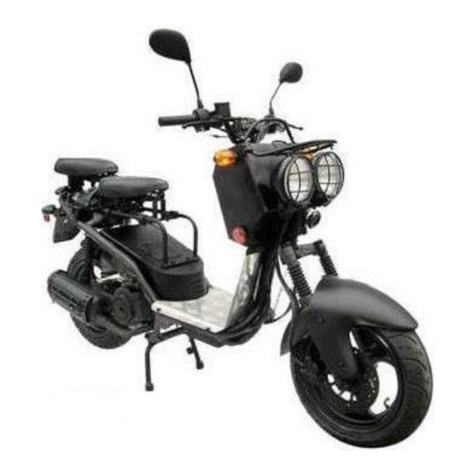
TNG
TNG 150cc User manual
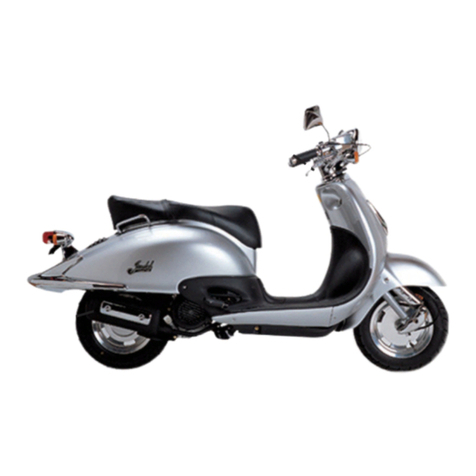
TNG
TNG Low Boy 150cc LB150T-L User manual

TNG
TNG Milano 49cc User manual
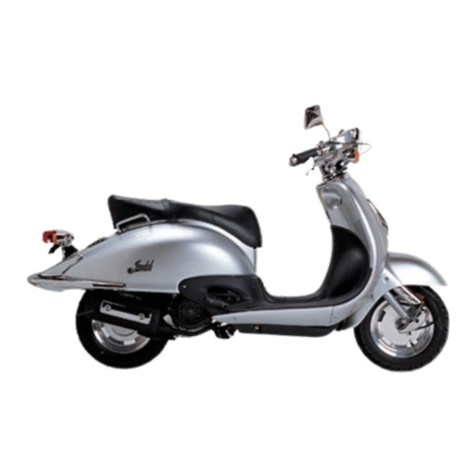
TNG
TNG TN'G Low Boy User manual
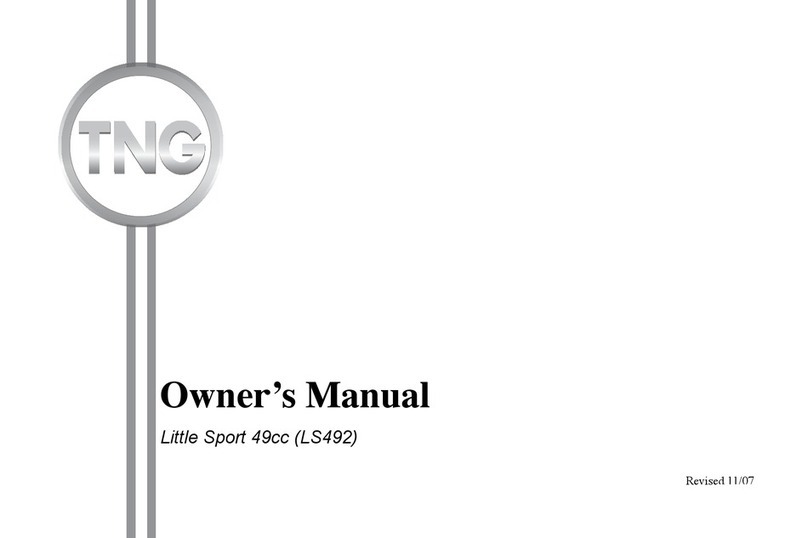
TNG
TNG Little Sport User manual

TNG
TNG Grand Sport 150cc User manual

TNG
TNG Milano User manual
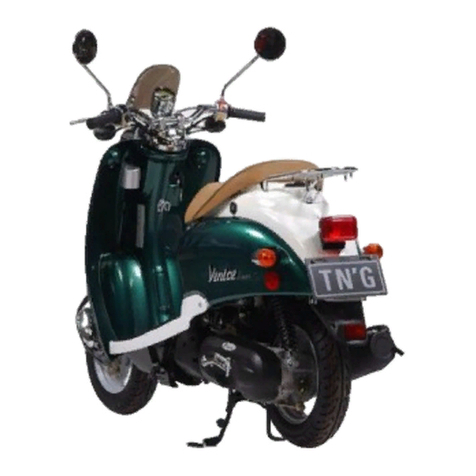
TNG
TNG Venice 49cc (VN492) User manual
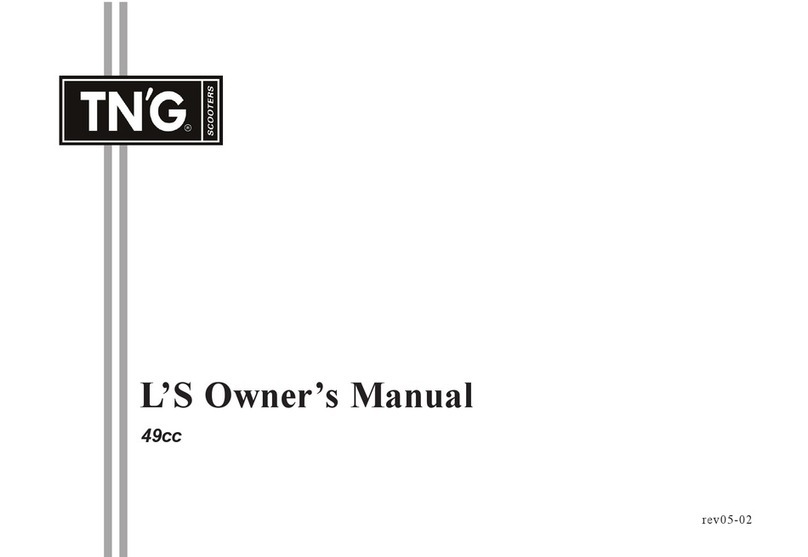
TNG
TNG L'S User manual

TNG
TNG TN'G DR150cc User manual
